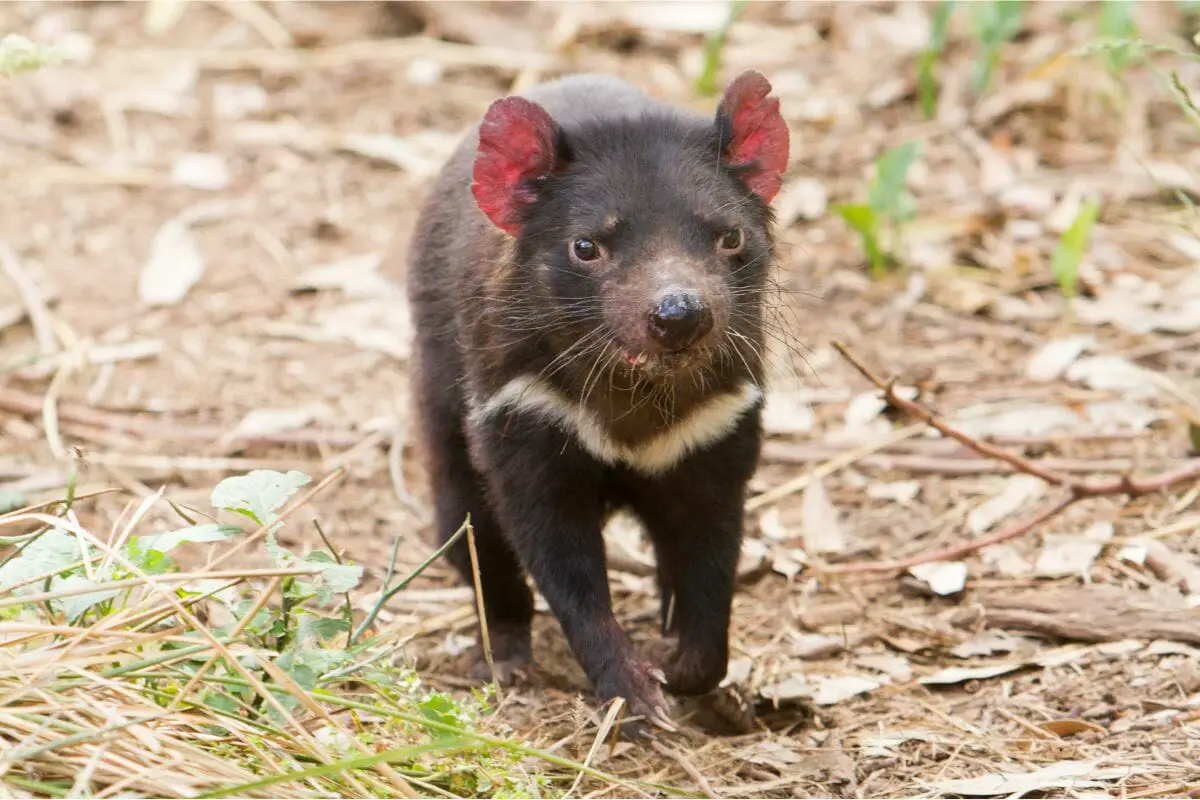When many of us think of the Tasmanian devil, we think of the old dim witted, ferocious Looney Tunes character, who would spend the entirety of his day chasing prey.
The Tasmanian devil would also offer some characteristic grunts and growls, which became a signature for his character.

But, are any of these attributes applicable to the real Tasmanian devil residing in the depths of Australia?
There are so many unanswered questions about these fascinating creatures, including how fast they can actually run. In order to find out more about these animals, simply keep reading below.
How Fast Can The Tasmanian Devil Run?
Let’s jump straight in and answer our titular question. Just how fast can a Tasmanian devil actually run in the wild?
Well, we all knew that these creatures were fast runners, but the speed at which they travel is quite surprising.
A fully grown Tasmanian devil running over a short distance can actually travel at around 8.1 miles per hour.
This is incredible, considering that they’re not as muscular as other members of the marsupial family.
What Is The Personality Of A Tasmanian Devil?
The Tasmanian devil does indeed, have a ferocious personality, just like the Looney Tunes rendition.
It is known for its fierce nature, and it will spend a lot of time in combat with other creatures in the animal kingdom.
When faced with an opponent, particularly one of the same species, the Tasmanian devil’s cheeks will turn a crimson red, as they prepare for confrontation.
They will then open up their jaws as wide as possible, in order to threaten the opponent with their impressive set of teeth.
The Tasmanian devil will make a series of grunting and screeching noises in order to try and frighten their opponents, before resorting to fighting.
Fighting another Tasmanian devil is usually a last resort, when the previous methods of intimidation have not worked.
Sometimes, when a confrontation between two of these animals becomes particularly stressful, they will release an incredibly pungent odor from their glands.
Another thing that they do from time to time in moments of combat is release a very powerful sneeze, which is meant to drive the other away.
How Do They Communicate With Others?
When communicating with other members of their family, the Tasmanian devil is well known for uttering a series of different shrieks.
This will accompany the visual aspect of what’s currently happening.
When they stalk their prey during the nighttime, Tasmanian devils will use their sense of smell, as well as their incredibly long whiskers to stalk and eventually catch their prey.
Where Did The Name Come From?
Many of you reading this article are wondering why exactly Tasmanian devils are named as such, after all, they’re rather cute looking.
The name Tasmanian devil actually comes from early European settlers, who came to Tasmania.
Whilst they were on the island, they heard a series of strange and unsettling noises, which they believed came from a bush nearby.
They said that the noises sounded like growls, coughs, and screams, and had an almost unearthly feel to them.

Becoming extremely unsettled by these noises, they proceeded to investigate. Upon inspection, they found the Tasmanian devils that we all know today.
The reason why they called them devils is because of their stark black coat, wide jaws, sharp teeth, and crimson colored ears. We suppose that the creepy noises didn’t help either.
How Do Tasmanian Devils Reproduce?
The reproductive process for Tasmanian devils is very much like the others in the marsupial family. Their mating season will begin in the springtime, where they will mate with another of their kind.
The mating period can be particularly ferocious, and many of the males of the species will compete with one another in order to win the affections of the female.
After they have competed, and a victor is found, the male Tasmanian devil will then engage in a wrestling match with the female.
The female and male will wrestle together, and this is another opportunity for the male Tasmanian devil to prove his worthiness to the female.
If she believes that he has won the wrestling match, then she will believe that he is fit to bear her children.
The wrestling session is quite a thing to behold, as it can become incredibly aggressive. The pair will utter a series of different shrieks, grunts, and growls during the process.
The interesting thing about Tasmanian devils, is that they will mate with a series of different partners at very close time capacities.
The female will mate with a series of different males, and the males will mate with a series of different females.
One set of Tasmanian devils will mate several times too, so there’s a lot of mating going on.
The result is that a Tasmanian devil mother might carry children from several different fathers in her stomach, depending on the frequency of mates she has engaged with.
Like many marsupials, the pregnancy of the Tasmanian devil is incredibly short, in fact, it only lasts a total of three weeks.
This is common within this family, and their relative, the possum, is only pregnant for a total of 14 days.
The reason why they are pregnant for such a short amount of time, is because the majority of their babies development happens outside of the womb.
Many people, when they think of pouches, assign them exclusively to kangaroos. This however, isn’t the case, and all marsupial mothers will have a pouch in front of their stomachs to carry their young in.
Another interesting fact is that all marsupial babies are called ‘joeys’, not just kangaroo babies.
The Tasmanian joeys, after they’ve emerged from their mother, will somehow crawl up their mother’s stomach, where they will continue to reside for the rest of their development.
It is incredible that they’re able to make it to the pouch in the first place, as when they are born, they are often only the size of a grain of rice.
Some Facts
- Tasmanian devils have incredibly powerful jaws, and they have a bite strength of 1200 PSI.
- They spend more time fighting and biting each other than other species in the animal kingdom
- They are able to keep and store food within the confines of their tails.
- Because their jaws and teeth are so powerful, they eat all of their prey’s carcass, even the bones
Final Thoughts
To sum up, Tasmanian devils are able to run at around 8.1 miles per hour when covering short distances. They are incredibly powerful animals, and will devour their prey with their incredibly sharp teeth.
Because they have such strong digestive systems, as well as teeth, they have even been known to eat the bones of their prey, leaving nothing behind.








